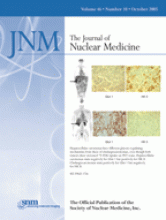TO THE EDITOR: I have read the recent JNM supplement on the clinical practice of molecular radiotherapy (1) with great interest and enthusiasm. The editors have done a superb job of bringing out the importance of radiotherapy, besides PET/CT molecular imaging, in the future growth of nuclear medicine. There are comprehensive sections on radiodosimetry, oral treatments, and various intravenous treatments. But there appears to be an omission in the area of emerging intraarterial treatments, such as 90Y-microspheres for hepatocellular and metastatic liver cancers (2–5). Because nuclear medicine is a part of intraarterial interventional radiologic or surgical procedures, it may be important for readers to be aware of the possibility that such procedures may offer a vast integral opportunity in the future. In addition, because nuclear medicine procedures such as PET, PET/CT, arterial 99mTc-macroaggregated albumin scans, multiple gated acquisitions, and bone scans are often used in both initial treatment planning and subsequent monitoring of response, a separate section on these aspects would also have been enlightening to our profession.
REFERENCES
REPLY:
We appreciate the comments from Dr. Wong regarding radiotherapy with 90Y-microspheres. As Dr. Wong quite rightly points out, the lack of a chapter on 90Y-microspheres within our supplement (1) was an omission, which should be corrected in the future, since the product (SIR-Spheres; Sirtex Medical Limited) has been approved for use in the United States.
This therapy provides an alternative to radiation or chemotherapy in nonresectable cases of liver cancer. Unlike external-beam radiation, which can harm normal tissue, this method takes advantage of the greater arteriolar density of hepatic tumors for selective delivery of radiation via microspheres that become trapped in the tumor microcirculation. Significantly greater radiation exposure to the tumor results from this method than from external irradiation, with little damage to the normal tissue. Many liver tumors, including carcinoid, are quite sensitive to radiation and highly suitable for this therapy. A number of studies done abroad have shown the usefulness of 90Y-microspheres and 131I-Lipiodol in the treatment of inoperable hepatocellular carcinoma, prevention of recurrence, and improvement of prognosis and survival in patients with hepatocellular carcinoma (2–4).
90Y-Microspheres were evaluated in a phase I study to assess safety and therapeutic benefit with absorbed raidiation dose ranging from 50 to 150 Gy in patients with unresectable hepatocellular carcinoma or with carcinoma metastatic to the liver (colorectal, neuroendocrine, carcinoid, islet cell tumors) (5–7). The use of SIR-Spheres in combination with chemotherapy has been shown useful for metastatic colorectal carcinoma (8,9) and has been approved by the U.S. Food and Drug Administration. Another commercial product is TheraSpheres (Theragenics).
In the past, the approved uses of these products were restricted; however, with increasing evidence of the effectiveness of therapy, their use is likely to grow. Further discussion and a comprehensive review of this topic will greatly enhance the awareness of this therapy. We support and recommend publication of a focused review on 90Y-microspheres.







